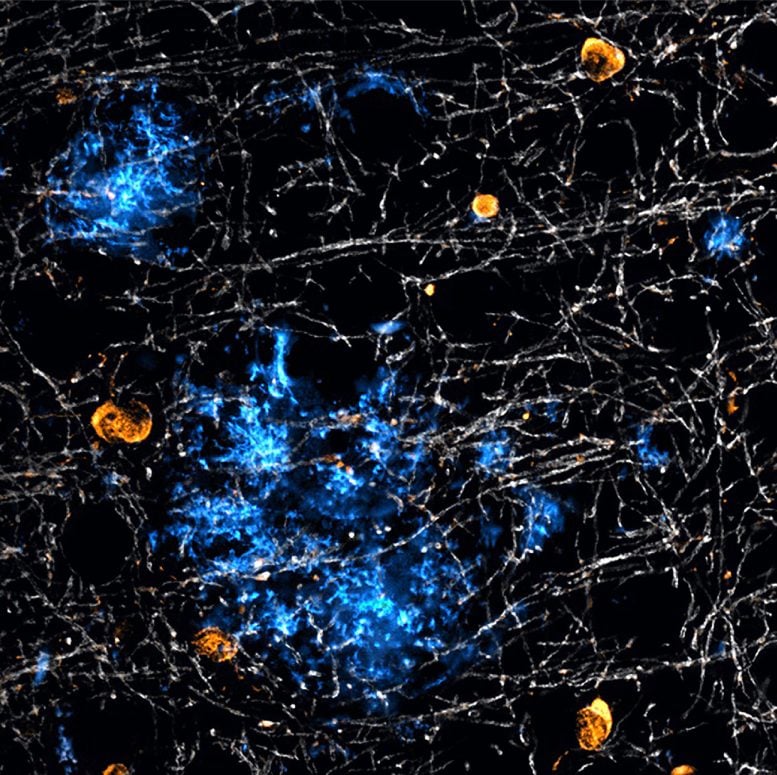Harmful proteins are also produced by glial cells.
Memory loss, confusion, and speech difficulties are hallmark symptoms of “Until now, neurons were thought to be the main producers of amyloid beta and have been the main target for new drugs,” explains Klaus-Armin Nave, Director at the MPI for Multidisciplinary Sciences. Results from his Department of Neurogenetics have now shown: In addition to neurons, special glial cells – called oligodendrocytes – play an important role in plaque formation. “One of the tasks of oligodendrocytes is to form myelin – an insulating layer – and wrap it around the nerve fibers to speed up signal transmission,” explains Andrew Octavian Sasmita, one of the first authors of the study now published in Nature Neuroscience and a former PhD student in Nave’s team. In a previous study, the Göttingen researchers had already discovered that defective myelin of oligodendrocytes exacerbates Alzheimer’s disease. Do glial cells play an even greater role in the disease than previously thought? “We have now shown that although neurons are the main producers of amyloid beta, oligodendrocytes also produce a significant amount of the protein which is incorporated into plaques,” says Sasmita. A research group led by Marc Aurel Busche of the University College London (England) recently came to similar conclusions. The cells of the nervous system produce amyloid beta by cleaving a larger precursor molecule with the help of an enzyme called BACE1. For their experiments, the researchers specifically knocked out BACE1 in the neurons and oligodendrocytes of mice. They then used 3D light-sheet microscopy to study plaque formation throughout the brain, providing a complete picture of amyloid plaques in all brain regions. “Oligodendrocytes lacking BACE1 developed about 30 percent fewer plaques. Knocking out the BACE1 gene in neurons reduced plaque formation by over 95 percent,” says Constanze Depp, also a first author of the study and a former PhD student in Nave’s department. The scientists also found out: “Plaque deposits only form when a certain amount of neuronal amyloid beta is present. The oligodendrocytes then contribute to these plaques.” This threshold could be useful for Alzheimer’s therapies. “If we can successfully inhibit BACE1 before this threshold is reached, the plaques might form later,” Nave emphasizes. That could help to slow down the progression of Alzheimer’s disease at an early stage. Reference: “Oligodendrocytes produce amyloid-β and contribute to plaque formation alongside neurons in Alzheimer’s disease model mice” by Andrew Octavian Sasmita, Constanze Depp, Taisiia Nazarenko, Ting Sun, Sophie B. Siems, Erinne Cherisse Ong, Yakum B. Nkeh, Carolin Böhler, Xuan Yu, Bastian Bues, Lisa Evangelista, Shuying Mao, Barbara Morgado, Zoe Wu, Torben Ruhwedel, Swati Subramanian, Friederike Börensen, Katharina Overhoff, Lena Spieth, Stefan A. Berghoff, Katherine Rose Sadleir, Robert Vassar, Simone Eggert, Sandra Goebbels, Takashi Saito, Takaomi Saido, Gesine Saher, Wiebke Möbius, Gonçalo Castelo-Branco, Hans-Wolfgang Klafki, Oliver Wirths, Jens Wiltfang, Sarah Jäkel, Riqiang Yan and Klaus-Armin Nave, 5 August 2024, Nature Neuroscience.
Preventing plaque formation
DOI: 10.1038/s41593-024-01730-3











/https://tf-cmsv2-smithsonianmag-media.s3.amazonaws.com/filer_public/d1/82/d18228f6-d319-4525-bb18-78b829f0791f/mammalevolution_web.jpg)







Discussion about this post